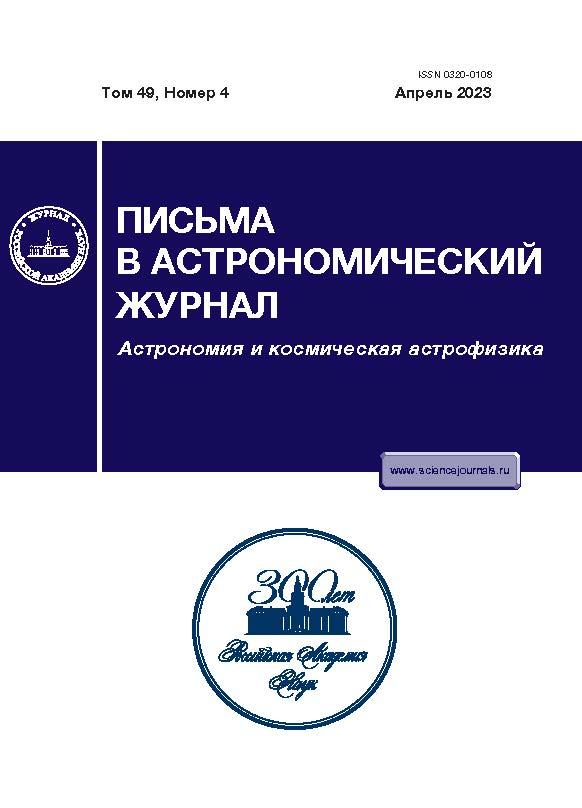Volume 49, Nº 4 (2023)
- Ano: 2023
- Artigos: 5
- URL: https://cardiosomatics.ru/0320-0108/issue/view/12631
Edição completa
Articles
SDSS-IV MaNGA: Ionization Sources of the Extra-planar Diffuse Ionized Gas
Resumo
We investigate the ionization sources of the diffuse gas at various galactic heights in galaxies with various stellar masses, H
luminosities, and specific star formation rates. For this purpose, we use the SDSS-IV MaNGA DR16 data and the theoretical models of photoionization and shock ionization from the Mexican Million Models database (3MdB). Our final sample contains 239 edge-on galaxies, which makes the results statistically significant and allows even great galactic heights to be investigated using the spectra stacking procedure. Using diagnostic diagrams, we show that for galaxies of all the types being investigated the behavior of the diffuse ionized gas is adequately described by the models of photoionization by young OB stars and hot low-mass evolved stars. However, in galaxies with high stellar masses or passive star formation shocks can also contribute to the ionization. For galaxies of all the types being investigated we find that the flux from OB stars and the ionization parameter decrease with height, while the relative contribution of hot low-mass evolved stars to the ionization increases. The greatest difference of the contributions from these sources to the gas ionization is observed between galaxies with different specific star formation rates and different stellar masses: hot low-mass evolved stars are the main source of gas ionization in galaxies with passive star formation (and with high stellar masses), whereas in galaxies with active star formation (and with lower stellar masses) OB stars are a decisive factor of the diffuse gas ionization.
 237-254
237-254


Theoretical Mass Estimates for the Mira-Type Variable R Hydrae
Resumo
Calculations of stellar evolution at initial abundances of helium
and heavier elements
were done for stars with masses on the main sequence
. Evolutionary sequences corresponding to the AGB stage were used for modelling the pulsation period decrease observed for almost two centuries in the Mira-type variable R Hya. Diminution of the period from @ 495 d in the second half of the eighteenth century to @ d in the 1950s is due to stellar radius decrease accompanying dissipation of the @ diation–diffusion wave generated by the helium flash. For all the history of its @bservations R Hya was the fundamental mode pulsator. The best agreement with @ bservations is obtained for eight evolutionary models with initial mass @ and the mass loss rate parameter of the Blöcker formula @. Theoretical mass estimates of R Hya are in the range @, whereas the mean stellar radius (@) corresponding to the pulsation period @ d agrees well with @easurements of the angular diameter by methods of the optical @nterferometric imaging.
 255-263
255-263


The Cepheids V371 Per and OGLE-LMC-CEP-2132: The First Crossing of the Instability Strip
Resumo
For both periods of the double-mode Cepheid V371 Per and for the Cepheid OGLE-LMC-CEP-2132 we have constructed
diagrams spanning a time interval of 126 and 119 years, respectively. The
diagrams have the shape of parabolas, which has allowed us for the first time to determine the quadratic light elements and to calculate the rates of evolutionary changes in their periods: @ s yr-1 and @ s yr-1 for the fundamental mode and the first overtone of V371 Per, @espectively, and @ s yr-1 for OGLE-LMC-CEP-2132, in agreement with the results of theoretical calculations for the first crossing of the instability strip. The pulsation stability test proposed by Lombard and Koen has confirmed that the increase in the periods is real.
 264-279
264-279


Secular Dynamics of a Number of Planets from the TESS Catalog Detected in Binary Star Systems
Resumo
We have investigated the stability of the orbital dynamics of a number of planets detected in binary star systems based on the analysis of data from the TESS orbital observatory. For 20 circumstellar planets we have obtained typical estimates of the Lyapunov time (the time of predictable dynamics). The secular orbital dynamics of 18 planets considered is stable with Lyapunov times greater than 6000 years. For the planets TOI-905b and TOI-1634b the calculated Lyapunov times (less than 3000 years) correspond to unstable dynamics and point to possible inaccuracies in the parameters of the planets found. A detailed analysis of the stability of the secular dynamics of the circumbinary planets TOI-1338 and TIC 172900988 has shown that on the stability diagrams the planets are located in regions with relatively large Lyapunov times (more than 7000 years), confirming the reliability of the derived parameters of the planets.
 280-288
280-288


Collisional Plasma Temperature and Betatron Acceleration of Quasi-thermal Electrons in Solar Flares
Resumo
Based on the model of a collapsing magnetic trap, we consider the influence of the temperature of a Maxwellian flare plasma on the efficiency of the betatron acceleration of quasi-thermal fast electrons in the cusp region of coronal loops. We show that an increase in the temperature causes a sharp growth (by 6–8 orders of magnitude) in the number density of quasi-thermal electrons which are capable of overcoming the ‘‘Coulomb loss barrier.’’ This suggests the necessity of background plasma preheating in the cusp region to
MK, for which the betatron mechanism can be responsible. We discuss the connection between the impulsive phase of flare energy release and the X-ray precursors of solar flares.
 289-298
289-298












